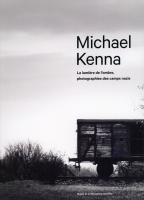
La lumière de l’ombre, photographies des camps nazis
2021
84 Photographs
Published by: Musée de la Résistance nationale
Exhibition catalog.
Following an exceptional donation by artist Michael Kenna, the National Resistance Museum presents teh exhibition Michael Kenna: Shadow of Light, Photographs of Nazi Camps, from October 23, 2021 to April 15, 2022, the museum's first temporary exhibition in its new Aimé-Césaire site, located in Chamigny-sur-Marne (Val-de-Marne).
Michael Kenna's work around Nazi camps comes from his school years. He is a photographer born in Widnes, England, in 1953. While working in the Banbury Art School communal darkroom, he experienced a photograph of the Auschwitz-Birkenau camp taken by another student, that of a mountain of shaving brushes.
Michael undertook for more than 15 years, at his own expense, numerous trips to photograph the remains of the Nazi camps, which at the time were abandoned, all over Europe. In 2001, through the Patrimoine photographique, Michael Kenna donated to France 301 original photographic prints made of Nazi prisons, concentration camps and killing centers, along with the original negatives. Michael Kenna gave the rights of universal transmission for the purposes of memory. He also decided that this work may not be subject to any commercialization. Between 2011 and 2021, continuing the process, he dontated the remaining work prints, negatives and original prints resulting from this memorial work to the Museum of National Resistance (MRN) of Champigny-sur-Marne. This presents no less than 6,385 negatives, 6,472 contact prints, 1,644 work prints and 261 exhibition prints.
The image is also an object memory. Because he is a landscape photographer, Michael Kenna photographs the sites of the camps, making light emerge from the shadows. He approaches history and culture in a different way, focusing on the memory of the concentration camp universe and of the genocide of the Jews of Europe. Looking at these places, he reminds us that the Nazi camps have today become vestiges which only partially account for their functioning during the Second World War. At a time when the survivors and witnesses of the Deportation are becoming increasingly rare, he decided to help the transmission of this memory, using the art that he masters, that of photography. To offer a different look at these places, where the Nazis tried to destroy our humanity, was to help make oblivion possible.

